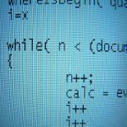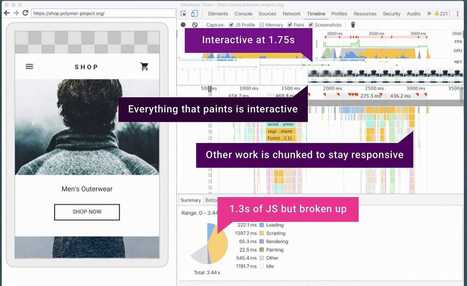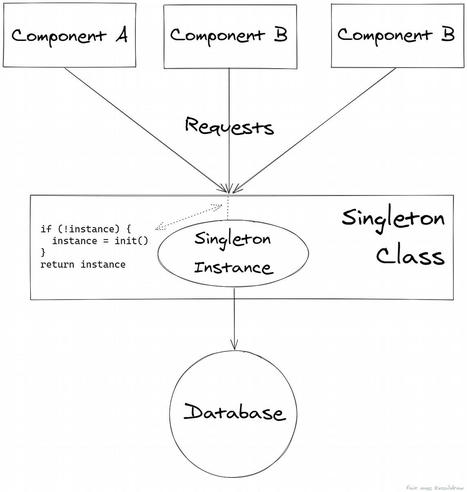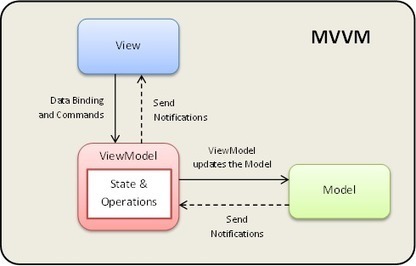 Your new post is loading...
 Your new post is loading...

|
Scooped by
Mickael Ruau
December 21, 2021 7:28 AM
|
The classic JavaScript design patterns book, updated to ES2015+ syntax.

|
Scooped by
Mickael Ruau
September 15, 2021 7:44 AM
|
Welcome readers, in this tutorial, we will learn the basics of different design patterns under the Microservices architecture. You can also check a

|
Scooped by
Mickael Ruau
February 12, 2021 2:39 AM
|
L' inversion de contrôle ( inversion of control , IoC) est un patron d' architecture commun à tous les frameworks (ou cadre de développement et d'exécution). Il fonctionne selon le principe que le flot d'exécution d'un logiciel n'est plus sous le contrôle direct de l'application elle-même mais du framework ou de la couche logicielle sous-jacente.

|
Scooped by
Mickael Ruau
October 18, 2020 6:10 AM
|
Addy Osmani (Adnan Osmani) is an engineering manager at Google working on Chrome. His teams work on tools like Lighthouse and PageSpeed Insights. He is author of open-source projects like Yeoman, TodoMVC and Material Design Lite. He has also written books like Learning JavaScript Design Patterns with O'Reilly.

|
Scooped by
Mickael Ruau
June 11, 2020 4:41 AM
|
Learn how to use Silverlight to create gorgeous mobiles apps for the Windows Phone. Included in this Refcard is everything from an explanation of the MVVM Design Pattern to some examples of MVVM Project Templates.

|
Scooped by
Mickael Ruau
October 9, 2018 8:09 AM
|
En programmation web, un polyfill aussi nommé shim ,, ou encore prothèse d'émulation désigne un palliatif logiciel implémentant une rétrocompatibilité d'une fonctionnalité ajoutée à une interface de programmation dans des versions antérieurs de cette interface.

|
Scooped by
Mickael Ruau
February 9, 2018 2:36 AM
|
PRPL is a pattern for structuring and serving Progressive Web Apps (PWAs), with an emphasis on the performance of app delivery and launch. It stands for: - Push critical resources for the initial URL route.
- Render initial route.
- Pre-cache remaining routes.
- Lazy-load and create remaining routes on demand.

|
Scooped by
Mickael Ruau
November 4, 2017 6:50 AM
|
Take advantage of the mediator design pattern to promote loose coupling and simplify the coding of object interactions

|
Scooped by
Mickael Ruau
August 30, 2017 2:27 AM
|
This popular pattern used by tons of JavaScript applications may save you from injecting costly dependencies in your project. Easy, clean and very useful.

|
Scooped by
Mickael Ruau
July 25, 2017 6:27 AM
|
Tired of learning yet another framework? Camilo Reyes teaches you how to implement the MVC design pattern (model-view-controller) in vanilla JavaScript.

|
Scooped by
Mickael Ruau
July 13, 2017 9:18 AM
|
In this article, we will see how some of the most important GoF design patterns apply to Node.js and its philosophy, thus rediscovering their importance from another perspective. The design patterns explored in this article are as follows: - Factory
- Proxy
- Decorator
- Adapter
- Strategy
- State
- Template
- Middleware
- Command

|
Scooped by
Mickael Ruau
March 16, 2017 4:44 AM
|
Gareth Evans and Rick Mugridge share the patterns that emerged while developing hypermedia APIs for various companies over time.

|
Scooped by
Mickael Ruau
December 2, 2016 10:55 AM
|
Dans ce cours vous allez découvrir la mise en oeuvre le pattern 'module' en JavaScript qui est une bonne pratique pour structurer son code.
|

|
Scooped by
Mickael Ruau
September 16, 2021 7:28 AM
|
Depuis quelques années, quand je découvre un projet je vois régulièrement des répertoires qui s’appellent : - Application
- Domain
- Infrastructure
Je me suis interrogé sur le sens de ces mots. Est-ce qu’ils sont liés à un pattern en particulier ? J’ai eu des réponses diverses en fonction des projets : - « C’est une architecture en couches »
- « C’est une architecture hexagonale »
- « C’est une Clean Architecture »
- « On fait du Domain-Driven Design (DDD) »
Quelle est la bonne réponse ? D’où viennent ces mots ? Quel intérêt à les utiliser ou ne pas les utiliser aujourd’hui ? Je me suis documenté sur le sujet et je vous propose un voyage dans le temps pour y voir un peu plus clair.

|
Scooped by
Mickael Ruau
May 18, 2021 5:27 AM
|
A l'époque pré-PHP 5.3 (1), les helpers avaient un sens, surtout s'ils avaient chacun un but précis (par exemple le helper URL), du moins au départ, mais à la fin on se retrouvait le plus souvent avec des classes qui contenaient du code spaghetti.
Certains diront que ceci est dû à un manque de PHP, qui comme Java ne permet pas l'héritage multiple (2), mais je pense qu'il s'agit toujours d'une confusion : du code réutilisable ne devrait pas se trouver dans des classes abstraites devant être héritées de partout (dédicace au framework Magento 1).
(1) PHP 5.3 a introduit la notion de namespace, identique au package Java, ouvrant la voie à la gestion séparée des modules sans collision de nom, à l'injection de dépendance et à Composer, le gestionnaire de dépendances de PHP.
(2) PHP Utilise les traits comme une alternative à ce manque, mais leur utilisation est rare car dangereuse. Quant à Java, il permet depuis sa version 8 de mettre du code dans des interfaces.

|
Scooped by
Mickael Ruau
February 3, 2021 7:08 AM
|
Les design patterns sont inévitables pour tous les développeurs. Si tu ne les connais pas, sache que tu les utilises déjà sans le savoir.

|
Scooped by
Mickael Ruau
August 28, 2020 8:10 AM
|
Avec LiveData et ViewModel, les développeurs Android ont à disposition des outils très puissants pour les aider à concevoir des applications plus fluides

|
Scooped by
Mickael Ruau
December 17, 2018 8:35 AM
|
Le patron de conception Post-Redirect-Get est une solution spécifique au protocole HTTP pour le développement de serveur web. Quand un utilisateur soumet un formulaire web (exemples : une commande, une souscription, une nouvelle version de page wiki) dont l'envoi est de type POST, le navigateur l'envoie avec la méthode POST, et reçoit une confirmation du serveur après traitement de la requête et du formulaire.

|
Scooped by
Mickael Ruau
February 17, 2018 3:34 AM
|
AngularJS is one of the most popular front-end JavaScript frameworks. It is used to create dynamic, interactive and responsive web applications. It is a full-featured Single Page Application (SPA) framework. Angular supports the principles behind the Model-View-Controller (MVC) design pattern. In this post, let us examine the concepts behind MVC and MVVM; also try to map Angular constructs to the MVVM pattern.

|
Scooped by
Mickael Ruau
February 9, 2018 2:29 AM
|
Comment mettre en place une architecture basée sur le MVVM (Model View ViewModel) à l’instar du MVC (Model View Controler) qui est plus souvent utilisé ?

|
Scooped by
Mickael Ruau
November 4, 2017 6:49 AM
|
Boost application performance by using the object pool design pattern to recycle objects that are expensive to create

|
Scooped by
Mickael Ruau
July 29, 2017 9:34 AM
|

|
Scooped by
Mickael Ruau
July 21, 2017 9:21 AM
|
Reactive programming has its roots in the observer pattern, as discussed in Erich Gamma, Richard Helm, Ralph Johnson, and John Vlissides's classic book Design Patterns: Elements of Reusable Object-Oriented Software (the authors of this book are commonly called GoF or Gang of Four). In the observer pattern, there is an observable subject. It has a list of listeners, and notifies all of them when it has something to publish. This is somewhat simpler than the publisher/subscriber (PubSub) pattern, not having potentially intricate filtering of which messages reach which subscriber which is a normal feature to include. Reactive programming has developed a life of its own, a bit like the MVC pattern-turned-buzzword, but it is best taken in connection with the broader context explored in GoF. Reactive programming, including the ReactJS framework (which is explored in this title), is intended to avoid the shared mutable state and be idempotent. This means that, as with RESTful web services, you will get the same result from a function whether you call it once or a hundred times.

|
Scooped by
Mickael Ruau
July 10, 2017 9:17 AM
|
Design patterns solve the problems by providing guidelines that are industry best practices to handle problems or achieve or implement any requirement. Singleton pattern, for example, is used to create only one instance that is shared among all; whereas, prototype is used to extend the existing functionality of an object by adding more properties, methods, and so on. Design patterns are classified into three categories creational, structural, and behavioral patterns. The topics that we will cover in this article are as follows: - Observer pattern
- Pub/sub pattern
- Promises

|
Scooped by
Mickael Ruau
December 7, 2016 4:07 AM
|
|
 Your new post is loading...
Your new post is loading...
 Your new post is loading...
Your new post is loading...



























